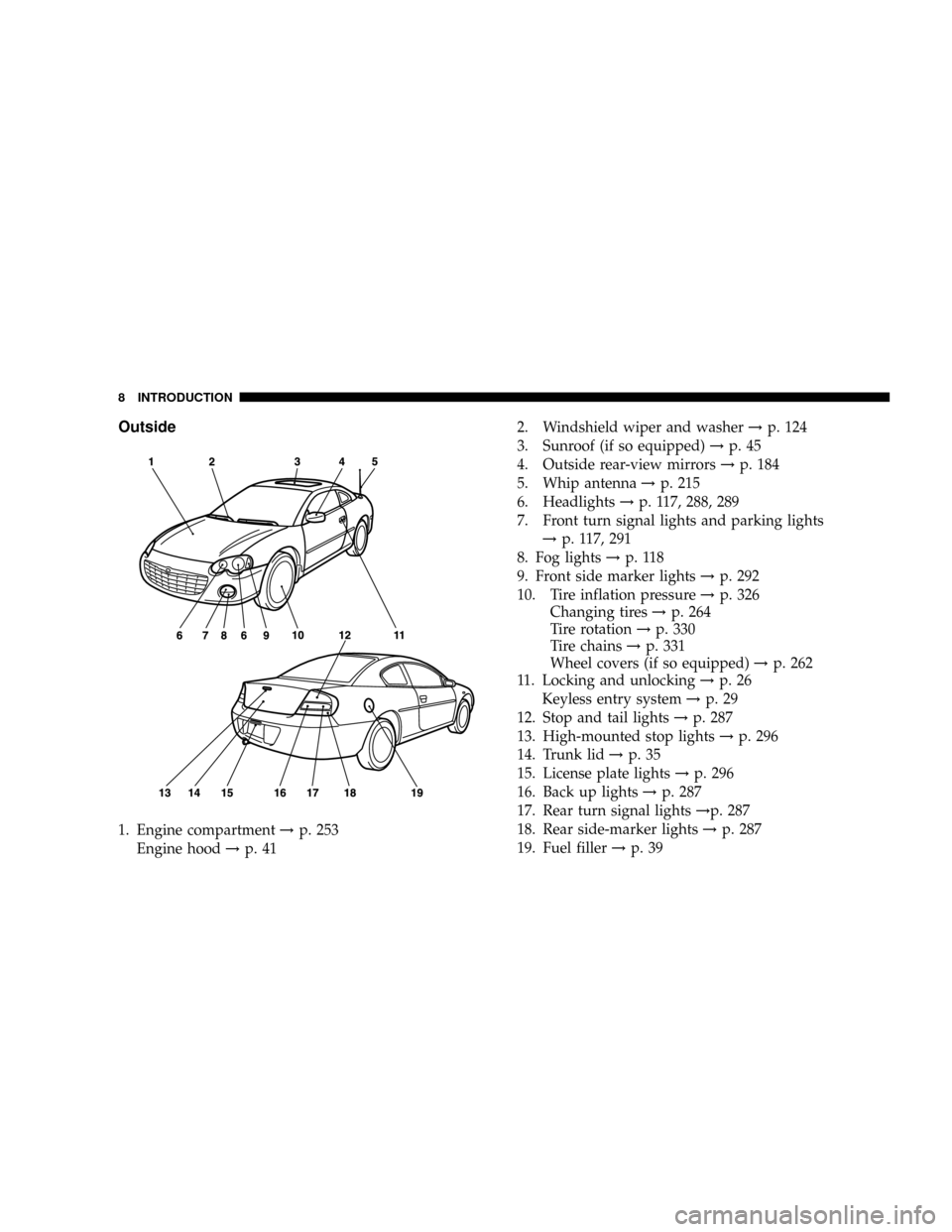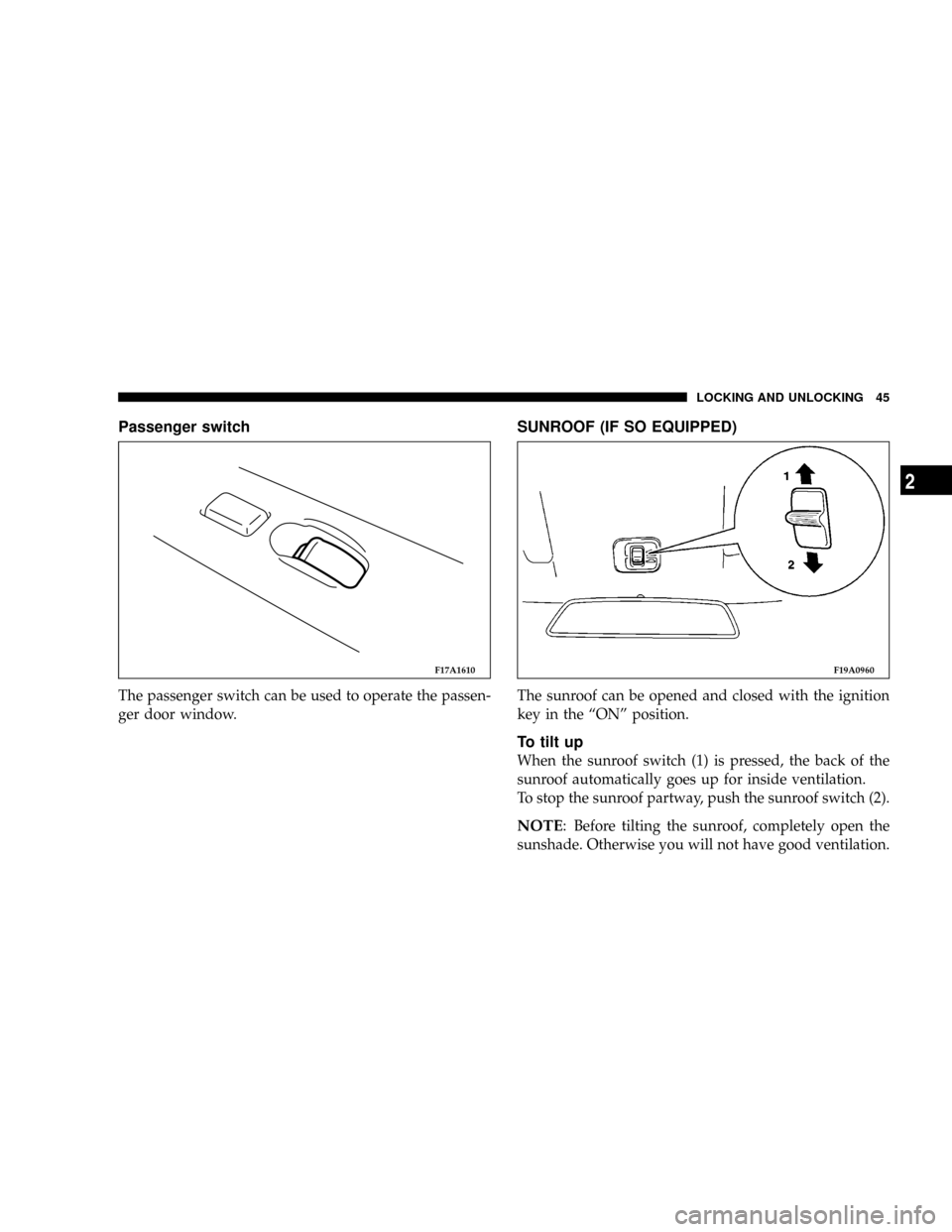roof CHRYSLER SEBRING COUPE 2004 2.G Owners Manual
[x] Cancel search | Manufacturer: CHRYSLER, Model Year: 2004, Model line: SEBRING COUPE, Model: CHRYSLER SEBRING COUPE 2004 2.GPages: 382, PDF Size: 2.23 MB
Page 7 of 382

Interior
1. Seat belt!p. 66
Adjustable seat belt shoulder anchor (for front
seats)!p. 712. Remote trunk lid release!p. 36
3. Power window switch!p. 43
4. Window lock switch!p. 44
5. Electric remote-controlled outside mirror
switch!p. 184
6. Power door lock switch!p. 34
7. Sun visor!p. 205
8. Sunroof switch (for vehicles with sunroof)!p. 45
Dome light (for vehicles without sunroof)!p. 127
9. Inside day/night rearview mirror!p. 173
Electrochromic inside rearview mirror (if so equipped)
!p. 174
Dome light (for vehicles with sunroof)
10. Vanity mirror!p. 206
11. Glove compartment!p. 210
12. Cup holder (for rear seat)!p. 208
13. Rear seat!p. 64
14. Center console with lid!p. 211
15. Supplemental restraint system-side air bag!p. 87
(for front seats, if so equipped)
16. Cup holder (for front seats)!p. 208
17. Front seat
18. Ash receptacle receiver.
INTRODUCTION 7
1
Page 8 of 382

Outside
1. Engine compartment!p. 253
Engine hood!p. 412. Windshield wiper and washer!p. 124
3. Sunroof (if so equipped)!p. 45
4. Outside rear-view mirrors!p. 184
5. Whip antenna!p. 215
6. Headlights!p. 117, 288, 289
7. Front turn signal lights and parking lights
!p. 117, 291
8. Fog lights!p. 118
9. Front side marker lights!p. 292
10. Tire inflation pressure!p. 326
Changing tires!p. 264
Tire rotation!p. 330
Tire chains!p. 331
Wheel covers (if so equipped)!p. 262
11. Locking and unlocking!p. 26
Keyless entry system!p. 29
12. Stop and tail lights!p. 287
13. High-mounted stop lights!p. 296
14. Trunk lid!p. 35
15. License plate lights!p. 296
16. Back up lights!p. 287
17. Rear turn signal lights!p. 287
18. Rear side-marker lights!p. 287
19. Fuel filler!p. 39
8 INTRODUCTION
Page 22 of 382

NPassenger switch.......................45
mSunroof (if so equipped)..................45
NTo tilt up.............................45
NTo tilt down..........................46
NTo open..............................46
NTo close..............................46NSunshade............................47mTheft-alarm system......................48
NArmed stage..........................48
NAlarm stage...........................50
NDisarmed stage........................51
NTesting the theft-alarm system..............52
22 LOCKING AND UNLOCKING
Page 45 of 382

Passenger switch
The passenger switch can be used to operate the passen-
ger door window.
SUNROOF (IF SO EQUIPPED)
The sunroof can be opened and closed with the ignition
key in the ªONº position.
To tilt up
When the sunroof switch (1) is pressed, the back of the
sunroof automatically goes up for inside ventilation.
To stop the sunroof partway, push the sunroof switch (2).
NOTE: Before tilting the sunroof, completely open the
sunshade. Otherwise you will not have good ventilation.
F17A1610F19A0960
LOCKING AND UNLOCKING 45
2
Page 46 of 382

To tilt down
Press the sunroof switch (2).
To stop the sunroof partway, release the sunroof switch.
To open
When the sunroof switch (1) is pressed, the back of the
sunroof automatically goes up.
When the sunroof switch (1) is pressed a second time, the
sunroof automatically opens completely.
To stop the sunroof partway, press the sunroof switch (2).
To close
The sunroof closes while the sunroof switch (2) is being
pressed.
To stop the sunroof partway, release the switch.
NOTE
1. The sunroof can be operated when the ignition key is
in the ªONº position. The sunroof can be opened or
closed for a 30-second period after the ignition switch is
turned off. However, once the driver 's door or the
passenger 's door is opened, the sunroof cannot be oper-
ated until the ignition switch is turned on again.
2. If the battery cable is disconnected or the fuse is
replaced while the sunroof is open, the sunroof will not
close normally even after reconnecting the battery cable.
In this case, use the following steps.
Press the switch (2) repeatedly to close the sunroof
completely. The sunroof will resume its normal operation
after this procedure is completed.
46 LOCKING AND UNLOCKING
Page 47 of 382

Sunshade
The sunshade can be opened or closed manually while
the sunroof is closed.
NOTE: The sunshade will operate together with the
sunroof only when the sunroof is opened.
CAUTION!
Do not attempt to close the sunshade when the
sunroof is opened.
WARNING!
²When leaving the vehicle unattended, be sure to
close the sunroof and remove the ignition key.
²Before operating the sunroof, make sure that
nothing can be trapped (head, hand, finger, etc.).
²Never leave a child (or other person who is
incapable of safely operating the sunroof switch)
in the vehicle alone.
NOTE
1. Do not stick your head, hand or anything else out of
the sunroof opening.
2. After washing the vehicle or after there is rain, be sure
to wipe off any water that is on the sunroof before
operating it.
F19A0770
LOCKING AND UNLOCKING 47
2
Page 48 of 382

3. Do not try to operate the sunroof if it is frozen closed
(after snowfall or during extreme cold).
4. Do not sit on or place heavy luggage on the sunroof or
roof opening edge.
5. Do not apply any force that may cause damage to the
sunroof.
6. When waxing your vehicle, be careful not to put any
wax on the weatherstrip (black rubber) around the sun-
roof opening. If stained with wax, the weatherstrip
cannot maintain a weatherproof seal with the sunroof.
7. Release the switch when the sunroof has reached a
completely open or completely closed position.
THEFT-ALARM SYSTEM
The theft-alarm system is designed to provide protection
from unauthorized entry into the vehicle. This system is
operated in three stages: the first is the ªarmedº stage, the
second is the ªalarmº stage, and third is the ªdisarmedº
stage. If triggered, the system provides both audible and
visual alarm signals.
Armed stage
Park the vehicle and stop the engine. Arm the system as
described below.
1. Remove the key from the ignition switch.
2. Make sure the trunk lid is locked.
F30A0010
Arm the system and leave.
48 LOCKING AND UNLOCKING
Page 247 of 382

VEHICLE CARE
CONTENTS
mCleaning the inside of your vehicle.........249
NPlastic, vinyl leather, fabric, and flocked parts . . 249
NUpholstery..........................249
NGenuine leather (if so equipped)...........250
mCleaning the outside of your vehicle........250
NForeign material.......................250
NWashing............................251
NDuring cold weather...................252
NWaxing your vehicle....................253NPolishing your vehicle..................254
NDamaged paint.......................254
NCleaning plastic parts...................254
NChrome parts........................255
NAluminum wheels (if so equipped).........255
NWindow glass........................255
NWiper blades.........................255
NCleaning the sunroof (if so equipped).......255
NEngine compartment...................255
7
Page 253 of 382

Waxing your vehicle
Wax your vehicle once or twice a year, or when painted
surfaces do not shed water well.
Apply a small amount of wax to painted surfaces with a
soft cloth. After the wax has dried, polish with a dry soft
cloth.
Do not wax your vehicle in direct sunlight.
You should wax after the surfaces have cooled.CAUTION!
²Waxes containing high abrasive compounds
should not be used. Such waxes remove rust and
stain effectively from the paintwork, but are
harmful to the luster of the painted surface, since
they also remove paint/clearcoat.
Further, they are detrimental to glossy surfaces
such as the grille, garnish, moldings, etc.
²Do not use gasoline, kerosene, benzene or paint
thinners to remove road tar or other contamina-
tion to the painted surface.
²Do not apply wax on the areas having black mat
coating as it can cause uneven discoloration,
patches, blurs, etc. If stained with wax, immedi-
ately wipe off with a soft cloth and warm water.
²Be careful when waxing the area around the
sunroof opening, not to apply any wax on the
weatherstrip (black rubber).
If stained with wax, the weatherstrip cannot main-
tain a weatherproof seal with the sunroof.
VEHICLE CARE 253
7
Page 255 of 382

Chrome parts
To prevent spots and corrosion of chrome parts, wash
with water, dry thoroughly, and apply a nonabrasive
automotive wax. If the chrome is severely damaged or
pitted use a commercially available chrome polish.
Aluminum wheels (if so equipped)
A protective coating is provided over aluminum wheels.
Clean aluminum wheels with a cleaner designed for use
on aluminum and apply an appropriate protection agent.
CAUTION!
²Do not use abrasive cleaners.
²Brushes may damage the aluminum wheel sur-
face. Be sure to use a sponge, chamois, etc.
²Do not apply hot water directly from a steam
cleaner to the wheel surface.
²Wheels exposed to sea water or road chemicals
should be cleaned as soon as possible.
Window glass
The window glass can be cleaned using only a sponge
and water. Glass cleaner can be used to remove wax, oil,
grease, dead insects, etc. After washing the glass, wipe
dry with a clean, dry, soft cloth.
Wiper blades
Use a soft cloth and glass cleaner to remove grease, dead
insects, etc., from the wiper blades.
Replace the wiper blades when they no longer clean the
windshield properly.
Cleaning the sunroof (if so equipped)
Clean the inside of the sunroof with a soft cloth. Hard
deposits should be wiped away with a cloth dipped in
warm, neutral detergent solution. Wipe away the solu-
tion with a sponge dipped in fresh water.
NOTE: The surface treatment on the inside of the glass
may be removed if a hard cloth or organic solvent is used.
Engine compartment
Never spray or splash water on the electrical components
in the engine compartment, as this may adversely affect
the electrical circuits.
VEHICLE CARE 255
7